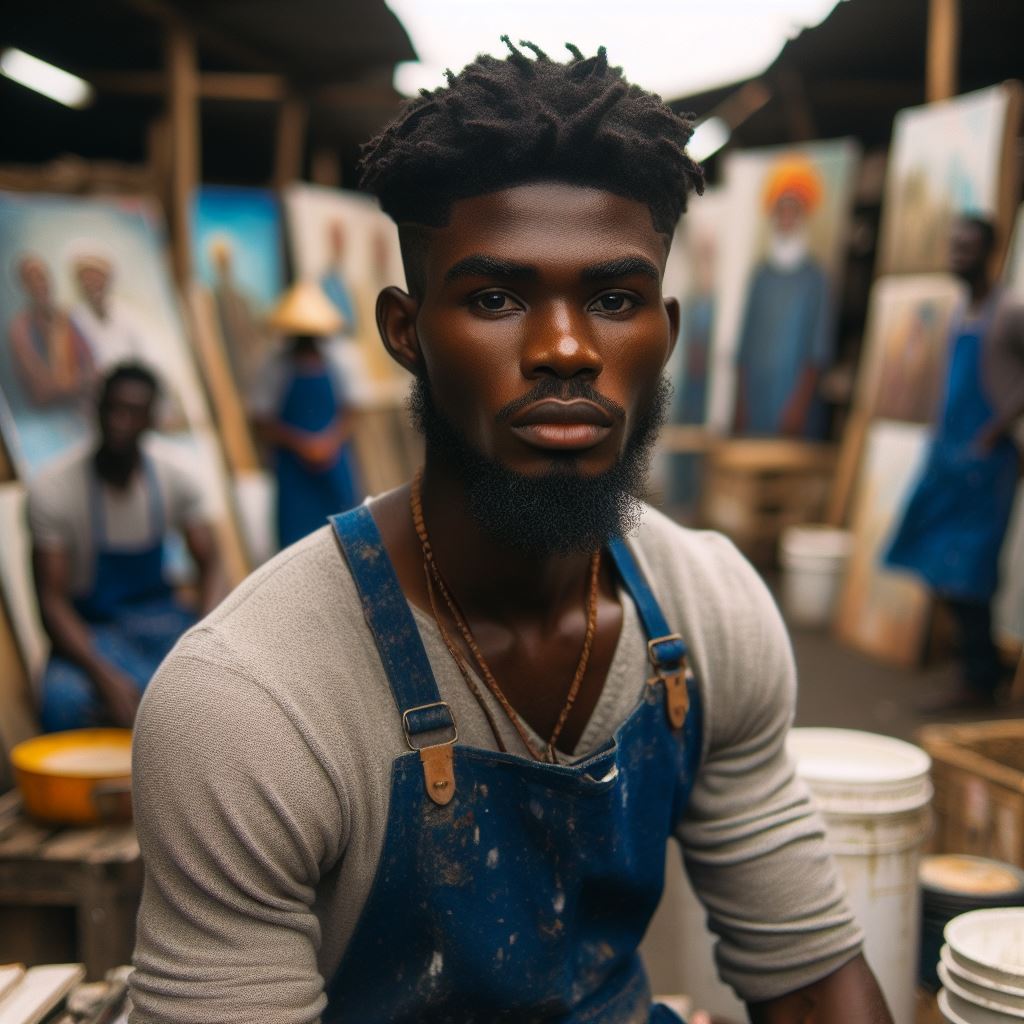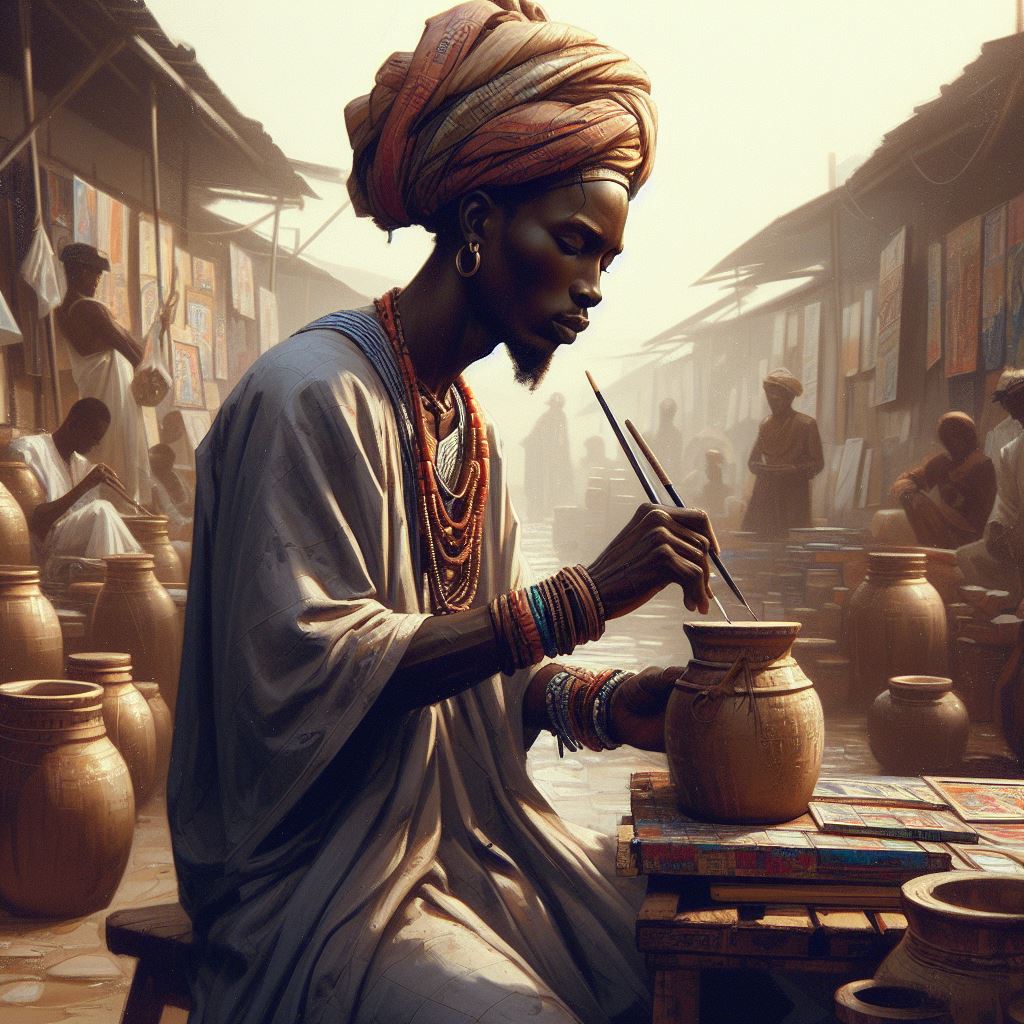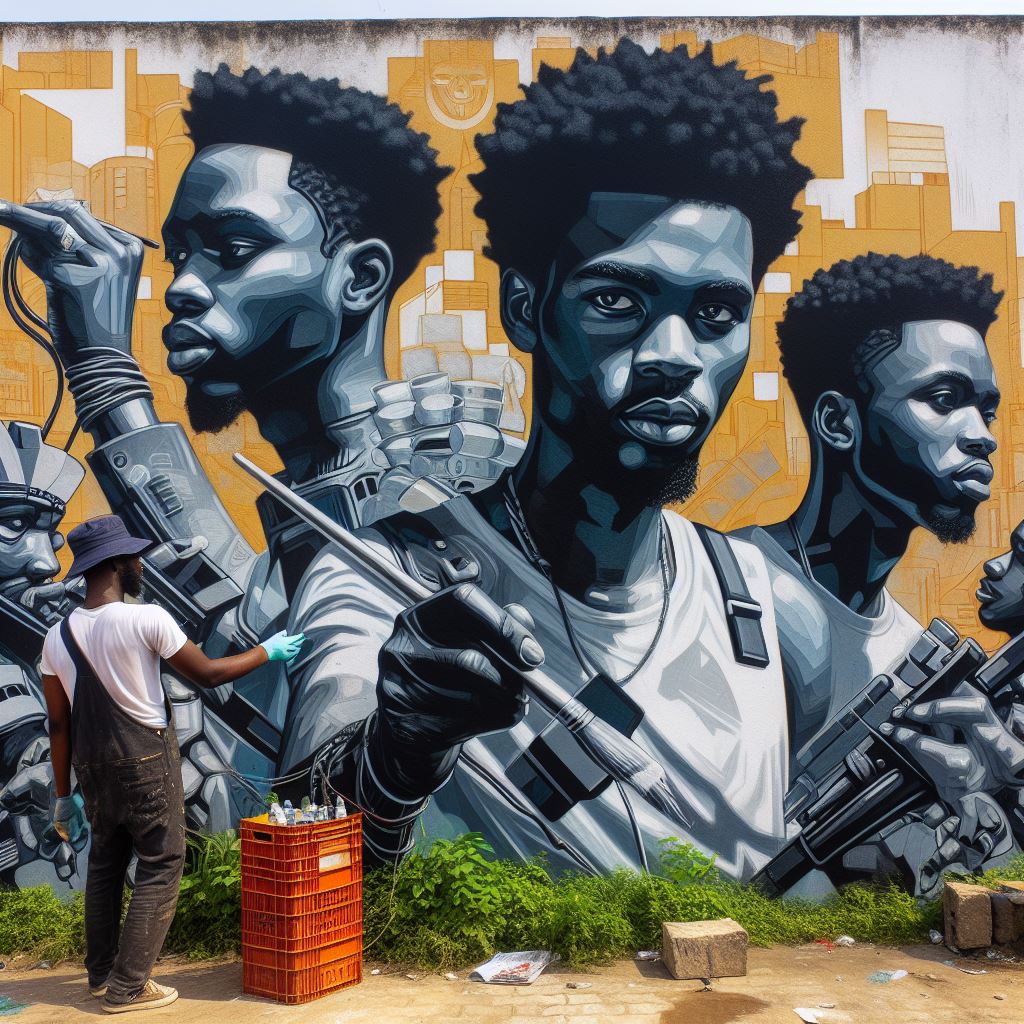Introduction
Nigeria’s art market stands as a vibrant tapestry interwoven with the nation’s rich cultural heritage and the boundless creativity of its artists.
These markets serve as bustling hubs where the pulse of artistic expression beats vigorously, offering a kaleidoscope of visual delights to enthusiasts and collectors alike.
Importantly, the significance of art markets in Nigeria transcends mere commercial transactions; they serve as vital conduits for the preservation and promotion of indigenous art forms, supporting artists in their endeavors while fostering cultural exchange and appreciation.
The purpose of this blog post is to embark on a comprehensive exploration of Nigeria’s dynamic art markets, unraveling the intricacies that shape their landscape.
We aim to unravel emerging trends, market forces, and the evolving preferences of both buyers and sellers.
By delving into these insights, we seek to offer readers a nuanced understanding of the multifaceted realm of Nigeria’s art markets and their profound impact on the country’s cultural identity and socio-economic fabric.
Through this journey, we invite readers to immerse themselves in the vibrant world of Nigerian art, where creativity knows no bounds and imagination reigns supreme.
Historical Perspective
When exploring the art markets in Nigeria, it is essential to delve into the historical perspective to understand the trends and insights that shape the industry today.
Overview of the Evolution of Art Markets in Nigeria
The art market in Nigeria has a rich history that dates back centuries, with traditional art forms playing a significant role in shaping the market over time.
Historically, Nigerian art was mainly focused on traditional forms such as pottery, sculptures, and textiles, which were integral to the cultural and spiritual practices of various ethnic groups.
Over the years, the art market in Nigeria has evolved to include a wide range of contemporary art forms, including painting, photography, and mixed media, reflecting the dynamic and diverse artistic landscape of the country.
Influence of Traditional Art on Contemporary Markets
The influence of traditional art on contemporary markets in Nigeria is evident in the themes, motifs, and techniques that artists incorporate into their work.
Many Nigerian artists draw inspiration from traditional art forms, incorporating elements such as indigenous patterns, symbols, and storytelling techniques into their contemporary pieces.
This fusion of traditional and modern influences has attracted both local and international collectors, contributing to the growth and diversification of the Nigerian art market.
Role of Colonialism in Shaping Nigerian Art Markets
Colonialism played a significant role in shaping the Nigerian art market, as it introduced Western artistic techniques, styles, and subject matters to the country.
During the colonial period, Nigerian artists were exposed to European art traditions, which influenced the way they created and presented their work, leading to a fusion of Western and indigenous artistic practices.
This fusion continues to impact the art market in Nigeria today, as artists navigate between preserving traditional art forms and embracing innovative approaches influenced by global trends.
Read: Innovations in Language Arts Teaching Methods
Trends in the Art Market
Emerging artists and their impact on the market
Emerging artists are reshaping Nigeria’s art market, injecting fresh perspectives and innovative techniques.
Their impact is evident in the growing diversity of artistic styles and themes embraced by collectors.
These new talents challenge traditional norms and bring contemporary issues into the artistic conversation.
Their work attracts a younger generation of collectors, eager to invest in fresh and provocative pieces.
Growing interest in Nigerian art internationally
Internationally, there is a burgeoning interest in Nigerian art, fueled by its cultural richness and artistic vibrancy.
Nigerian artists are increasingly gaining recognition on the global stage, with their works being exhibited and collected worldwide.
Major international galleries and auction houses now showcase Nigerian artists, reflecting this growing interest.
This global recognition has elevated the profiles of many Nigerian artists, leading to increased demand and higher prices.
Rise of online platforms for buying and selling art
The rise of online platforms has revolutionized the way art is bought and sold.
These platforms offer artists greater visibility and accessibility to a global audience, bypassing traditional barriers.
Art enthusiasts can now explore and purchase artworks from the comfort of their homes, fostering greater inclusivity.
Furthermore, online platforms facilitate direct engagement between artists and buyers, fostering a sense of community.
Despite the benefits, challenges persist, including concerns about the authenticity and provenance of artworks sold online.
Navigating the digital landscape requires vigilance and discernment to ensure a seamless and secure transaction.
However, the rise of online platforms presents new opportunities for artists to showcase their talents.
By harnessing the power of technology, artists can reach a broader audience and expand their market reach.
In short, the art market in Nigeria is undergoing dynamic changes driven by emerging artists, international interest, and digital innovation.
These trends reflect a vibrant and evolving landscape that promises exciting opportunities for growth and creativity.
Read: Research Areas in African and Asian Studies
Insights into the Nigerian Art Market
Key players in the market, including galleries and collectors
Galleries serve as vital hubs, not only showcasing artworks but also acting as intermediaries facilitating sales.
These galleries play a pivotal role in nurturing emerging talents, providing them with platforms to exhibit their works.
Additionally, collectors, both local connoisseurs and international aficionados, wield significant influence in the art market.
Their preferences and acquisitions not only shape market demand but also influence pricing trends.
Challenges faced by artists and buyers
Despite the vibrancy of Nigeria’s art scene, artists and buyers encounter various challenges in navigating the market.
One significant challenge is the limited access to funding and resources for emerging artists.
Securing funding for art projects, exhibitions, or studio spaces can often be a daunting task.
Moreover, artists and buyers must navigate authenticity issues and the prevalence of counterfeit artworks in the market.
Transform Your Career with Expert Guidance
Get personalized mentorship consulting that’s tailored to your unique path. Our expert advice is actionable and exclusive.
Get StartedFor buyers, ensuring the authenticity and provenance of artworks is essential to making informed purchasing decisions.
Opportunities for growth and development in the sector
Despite the challenges, Nigeria’s art market offers numerous opportunities for growth and development.
Emerging artists, in particular, can leverage digital platforms and social media to reach broader audiences.
By embracing technology, artists can showcase their works to a global audience, bypassing traditional barriers to entry.
Furthermore, collaborations between artists, galleries, and government agencies can foster a supportive ecosystem for artistic expression.
Investments in arts education and infrastructure development are also crucial for the sector’s growth.
By providing access to quality education and resources, aspiring artists can hone their skills and talents.
Moreover, initiatives that promote cultural exchange and collaboration can elevate Nigeria’s art scene on the global stage.
Overall, the Nigerian art market is teeming with potential, and by addressing challenges and seizing opportunities, it can continue to thrive and evolve.
Read: Exploring Semiotics in Communication Arts
See Related Content: Skills Needed for a Mass Communication Career Nigeria
Impact of Government Policies
Role of government in supporting the art market
The government’s role in supporting Nigeria’s art market is multifaceted and essential for its growth and sustainability.
Through strategic initiatives and policies, the government can provide crucial support to artists, galleries, and other stakeholders in the art ecosystem.
This support can take various forms, including financial assistance, infrastructure development, and advocacy for the arts.
One significant way the government can support the art market is by allocating funding to cultural institutions, museums, and galleries.
This financial support enables these institutions to curate exhibitions, acquire artworks, and provide educational programs to the public.
Additionally, government grants and subsidies can directly benefit artists, allowing them to pursue their creative endeavors without financial constraints.
Furthermore, the government plays a crucial role in promoting and protecting Nigeria’s cultural heritage.
By implementing policies that safeguard indigenous art forms, traditional craftsmanship, and historical landmarks, the government helps preserve the country’s unique cultural identity.
This preservation efforts not only enriches the art market but also contributes to national pride and identity.
Policies regulating the buying and selling of art
Policies regulating the buying and selling of art are essential for maintaining integrity and transparency within the art market.
These policies often include regulations related to art authentication, provenance documentation, and ethical standards for art dealers and collectors.
By enforcing such policies, the government can protect consumers from fraud and ensure that artworks are traded ethically and legally.
Moreover, government regulations can also address issues related to art export and import, taxation, and intellectual property rights.
Clear guidelines on these matters provide clarity and confidence to both buyers and sellers, facilitating smoother transactions and fostering trust in the art market.
Effect of economic policies on the art market
Economic policies, such as currency fluctuations, inflation rates, and trade regulations, can have a significant impact on the art market.
For example, changes in exchange rates can affect the affordability of artworks for international buyers and influence market demand.
Similarly, economic downturns may lead to reduced discretionary spending on art, impacting sales and market liquidity.
Additionally, taxation policies can directly affect the cost of buying and selling art, influencing market behavior and investment decisions. High import/export duties or sales taxes may discourage art transactions, while tax incentives for art purchases can stimulate market activity.
Overall, the interplay between government policies and the art market is complex and dynamic.
By implementing supportive and well-balanced policies, the government can foster a thriving and sustainable art market that benefits artists, collectors, and society as a whole.
Read: Cultural Exchange Between Nigeria and China

Uncover the Details: How to Apply for Music Courses in Nigeria
Case Studies
Successful Artists and Their Market Strategies
In the Nigerian art market, there are several artists who have found success through innovative strategies.
One such artist is Chike Oyeka, known for his vibrant and expressive paintings that capture the essence of Nigerian culture.
Oyeka’s market strategy involves leveraging social media platforms to showcase his work to a global audience.
By engaging with art enthusiasts on platforms like Instagram and Facebook, Oyeka has been able to attract collectors from around the world.
Another successful artist in Nigeria is Ngozi Ayogu, whose intricate beadwork has gained recognition both locally and internationally.
Ayogu’s market strategy focuses on collaborating with fashion designers to create wearable art pieces that appeal to a new demographic of art collectors.
By diversifying her portfolio and tapping into the fashion industry, Ayogu has been able to increase her visibility and sales.
Collectors and Their Experiences in the Nigerian Art Market
Collectors play a vital role in the Nigerian art market, driving demand for artworks and supporting artists in their careers.
One such collector is Emeka Okonkwo, a renowned art patron who has been collecting Nigerian art for over two decades.
Okonkwo’s experience in the art market has been a journey of discovery, as he has built a diverse collection that reflects the richness of Nigeria’s artistic heritage.
Through his passion for collecting, Okonkwo has not only contributed to the growth of the local art scene but has also gained valuable insights into the industry.
Another collector, Zainab Ali, has a different perspective on the art market, focusing on emerging artists and supporting them in their early careers.
By investing in young talent and nurturing their development, Ali has seen firsthand how her patronage can shape the future of Nigerian art.
Lessons Learned from Case Studies in the Industry
The case studies of successful artists and collectors in the Nigerian art market offer valuable lessons for aspiring individuals in the industry.
One key lesson is the importance of leveraging technology and social media to reach a broader audience and attract collectors.
By embracing digital platforms, artists can showcase their work to a global market, while collectors can discover new artists and trends from the comfort of their homes.
Additionally, collaboration and networking are essential components of success in the art market, as seen in the strategies of artists like Oyeka and Ayogu.
By forming partnerships with other creatives and industry professionals, artists can expand their reach and explore new opportunities for growth.
Similarly, collectors like Okonkwo and Ali demonstrate the impact of personal connections and relationships in building a meaningful art collection.
Through their interactions with artists and galleries, collectors can acquire valuable insights and develop a deeper appreciation for the artworks they collect.
Therefore, the case studies presented in the Nigerian art market showcase the diverse strategies and experiences of artists and collectors.
By learning from these examples and applying proven techniques, individuals in the industry can navigate the challenges and opportunities of the market with confidence and creativity.
Gain More Insights: Art and Technology: Innovations in Nigerian Art
You Might Also Like: Popular European Language Courses in Nigerian Institutes
Learn More: Career Opportunities with European Languages in Nigeria
Conclusion
In this blog post, we explored the vibrant art markets in Nigeria, highlighting key trends and insights.
The Nigerian art scene is growing rapidly.
The future of art markets in Nigeria looks promising, with increasing interest from local and international collectors.
This presents opportunities for Nigerian artists to showcase their talent on a global stage.
As the art market in Nigeria continues to evolve, it is essential for artists, collectors, and enthusiasts to engage with the growing community.
By supporting Nigerian art, we can nurture creativity and cultural exchange.
In closing, the art markets in Nigeria reflect the country’s rich cultural heritage and diverse artistic expressions.
It is a dynamic and ever-evolving landscape that offers exciting prospects for both artists and art enthusiasts.
We encourage readers to explore the Nigerian art market, attend exhibitions, and support local artists.
By actively engaging with the art scene in Nigeria, we can contribute to the growth and development of this thriving industry.
Take part in shaping the future of Nigerian art today!




